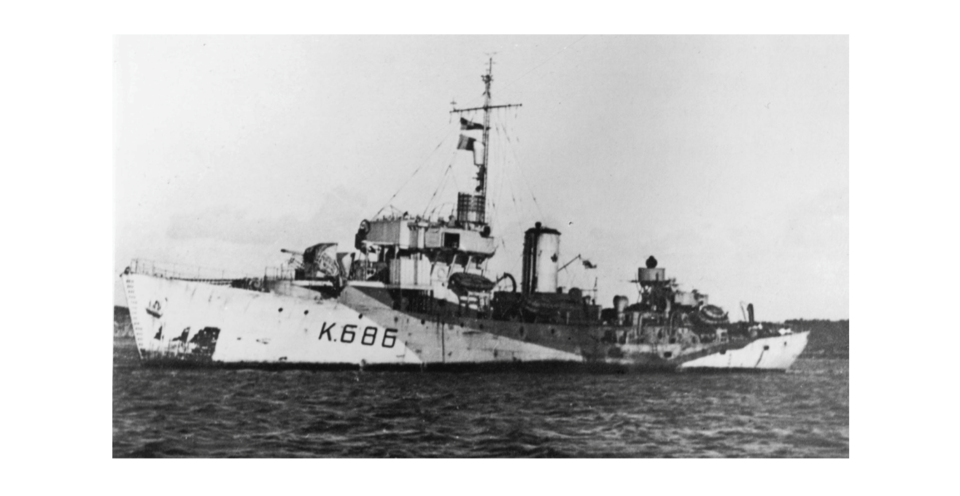On Nov. 14, 1944, an official delegation from Fergus was in Collingwood for a special occasion. They were there to watch the first sea trials on Georgian Bay of the newly-constructed corvette HMCS Fergus. Among the officers of the small warship was Lt. Lorne Simpson of Fergus.
Oddly, for a community far from the sea, Fergus was known as a sailor’s town because many of its citizens had been mariners. Three generations of the Foote family had been to sea, and at the time, two of the Foote clan were in service. Five Fergus men had been sea captains, two of whom still resided in the town. Other Fergus men were serving in the navy and the merchant marine.
The Fergus was the most recent (and as it turned out, the last to be built) of the Flower class corvettes that were the Allied answer to the German U-boats that terrorized the vital convoys crossing the North Atlantic from North America to Britain. A corvette was smaller than a destroyer, but it was especially designed and equipped for fighting U-boats. Winston Churchill called them “cheap and nasties.” The intention was that the U-boats would find the corvettes nasty to deal with, but the men who made up the corvette crews actually found them nasty to sail on. Corvettes tended to pitch and roll a lot on even the slightest ocean swell – some navy men said a corvette would roll on wet grass – and even the most experienced sailors got seasick when serving on them.
Admiral Percy W. Nelles of the Royal Canadian Navy had the idea of naming the ships after Canadian communities, believing they would then be more representative of the people who built them. Among the many cities and towns whose names were given to corvettes were Guelph, Kitchener, Brantford, Hespeler and Galt. The practise also encouraged the citizens of a community to “adopt” a ship and its crew. This was good for moral on the home front as it helped people feel that they were making a tangible contribution to the war effort.
The people of Fergus proudly took HMCS Fergus to their hearts. They had been enthusiastic about the ship since the previous June, when it had first been announced that a corvette would be called HMCS Fergus. Representatives of the town council and Hugh Templin, editor of the local newspaper, the News Record, kept the community informed of what was happening with the ship.
Weeks after the sea trials on Lake Huron, a delegation went to Toronto to watch their town’s namesake undergo gun tests on Lake Ontario. In spite of the tendency of corvettes to pitch more than other vessels, the Toronto Globe and Mail reported that the Fergus “dipped with dignity” on Lake Ontario’s swells.
HMCS Fergus was commissioned on Nov. 18. She was 63.5 meters long, 10.1 meters in the beam (the widest point), and had a top speed of 16 knots. She was armed with a four-inch gun, a two-pound gun, two 20mm guns, depth-charges, and a device for launching anti-submarine mortars called a Hedgehog.
Once again, a delegation from Fergus was present. In fact, about 300 people made the trip to Toronto, travelling by train, bus and car. They were given a tour of the ship and served lunch on board while a band from HMCS York played music. Father V.N Shea of Elora blessed the ship and crew.
The people of Fergus had donated money for gifts for the crew. They bought food items, cribbage boards, books, records, and wool that was used to knit socks and mitts. One special gift was a washing machine. When naval officials saw it, they were so impressed that the government decided to equip other ships with the appliance.
HMCS Fergus headed down the St. Lawrence River for the Atlantic Ocean. She conducted sea trials on runs between Halifax and Bermuda. At Christmas the skipper sent greetings to the town of Fergus. Then the ship entered convoy duty.
HMCS Fergus spent the next five months escorting cargo ships to the UK. She never sank a U-boat, though one of her convoys did come under attack. She was in the mid-Atlantic on a return voyage to Canada when word came by radio that Nazi Germany had surrendered on May 7, and the war in Europe was over.
Canada was still at war with Japan, but corvettes were thought to have too limited a range to be of much use in the Pacific war. The Fergus was not among the few that were sent west for coastal patrols. Dozens of the little warships were decommissioned at Quebec City and Sydney, Nova Scotia. On July 17 the Toronto Globe reported, to the great disappointment of the people of Fergus, that their adopted ship was on its way to the scrapyard.
However, the news of the demise of HMCS Fergus was premature. The ship was not scrapped, but sold and refitted as a merchant vessel. The reprieve was short-lived.
On Nov. 22, 1949, now called the Harcourt Kent, the former corvette was hauling coal from Sydney, Nova Scotia, when she struck a shoal near St. Shotts, Newfoundland, during a blizzard. All 18 crewmen were rescued thanks to the daring efforts of local fishermen, but the ship was lost.
However, HMCS Fergus has not been forgotten. At Branch 275 of the Royal Canadian Legion in Fergus, visitors can see a scale model of the corvette, as well as the ship’s bell and bible and a plaque. Reminders of the time a small Ontario town was connected to the Battle of the Atlantic.



